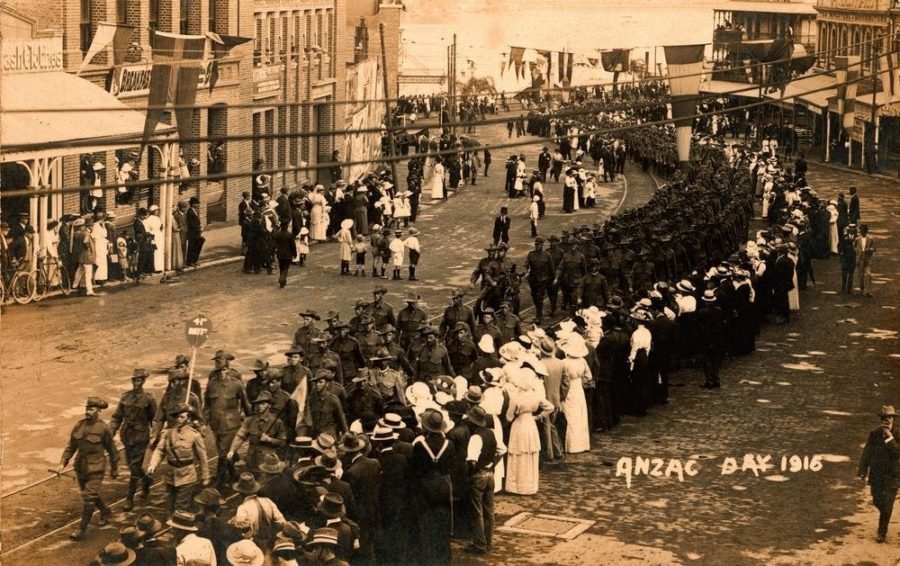Defining Moments in Australian History: First Anzac Day

On 25 April 1915, 16,000 Australian and New Zealand Army Corps (ANZAC) soldiers landed at what’s now called Anzac Cove, on Turkey’s Gallipoli peninsula. About 2000 were killed or wounded on that day alone. Weeks later, Australian newspapers published a flattering account of the landing by British war correspondent Ellis Ashmead-Bartlett and our soldiers’ deeds at Gallipoli came to be seen as a rite of passage for our fledgling country. That view was fostered by Charles Bean, Australia’s war correspondent and later official historian.
During 1914, various organisations had formed in Australia to raise funds for our troops and European civilians affected by the war. In mid-1915 many of them began holding fundraising days that combined patriotic displays with carnivals. In South Australia the Eight-Hour Day, an October public holiday characterised by pageantry and celebration, was renamed Anzac Day to raise funds for wounded soldiers.
By that year’s end all allied forces had been evacuated from Gallipoli and it was clear the campaign had failed. But the final death toll was huge – 8709 Australians, 2779 New Zealanders, tens of thousands of British and French troops and even more Turks – and many Australians felt the landing had been of enormous national significance and needed marking. Anzac Day organising committees formed spontaneously in each state.
The federal government recognised Gallipoli’s symbolic significance and hoped also that commemorating the campaign might reverse declining enlistments. In 1916 the acting prime minister and minister for defence, George Pearce, officially named 25 April as Anzac Day. All states marked it with a commemorative service and a march of new enlistees and Gallipoli veterans. In many towns, lunch was provided for veterans and most states held afternoon or evening festivities.
In Queensland, however, Anzac Day 1916 was organised by the Anzac Day Commemoration Committee, ensuring the day revolved entirely around commemoration. It forbade fundraising because that would involve a festive element deemed inappropriate. In contrast, Victorian organisers focused on fundraising through pageantry and celebration. In New South Wales, opinion was divided.
Sydney’s Lord Mayor, for example, was criticised by families of the dead for spending £1000 on decorative lighting for public buildings. And yet many returned servicemen urged the state government to make the day festive, reflecting what they thought fallen comrades would have wanted.
In London that year about 2000 sombre Anzacs marched through the streets, cheered on by enthusiastic Britons, before attending a commemorative service at Westminster Abbey. Troops stationed in Egypt held services for fallen comrades. Brigadier (later General Sir) John Monash explained in a letter to his wife that after the service in the troops took part in cricket, other games and “a great aquatic carnival”.
Anzac Day has been observed every year since and by the 1920s ceremonies were held throughout Australia. In 1927, for the first time, every state observed a formal public Anzac Day holiday. And by the mid-1930s all the present-day rituals – from dawn vigils to street marches and wreath-laying ceremonies – were part of Anzac Day culture. Most of these were devised and disseminated by Canon David Garland, a military chaplain and the energetic secretary of Queensland’s Anzac Day Commemoration Committee, who sought to make services ecumenical and accessible to all Australians.
Later, Anzac Day also served to commemorate Australians who died in World War II and all subsequent military and peacekeeping operations in which our nation has been involved. Attendance at Anzac Day events declined in the 1960s. Its popularity would be revived from the 1980s, in part, as there was a desire to honour the service of the declining number of veterans. Commemorative activities at Gallipoli had also become common.
Since the 1980s commemorative activities at Gallipoli itself have become common. In 1990, to mark the campaign’s 75th anniversary, prime minister Bob Hawke went to Gallipoli for Anzac Day, accompanied by a group of aged veterans of the conflict, the first prime minister to do so. Anzac Day has now regained much of its original status, with many seeing it as a way to honour the memory of our fallen soldiers.
‘First Anzac Day forms part of the National Museum of Australia’s Defining Moments in Australian History project.

